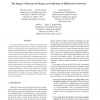Free Online Productivity Tools
i2Speak
i2Symbol
i2OCR
iTex2Img
iWeb2Print
iWeb2Shot
i2Type
iPdf2Split
iPdf2Merge
i2Bopomofo
i2Arabic
i2Style
i2Image
i2PDF
iLatex2Rtf
Sci2ools
ICDM
2008
IEEE
2008
IEEE
The Impact of Structural Changes on Predictions of Diffusion in Networks
In a typical realistic scenario, there exist some past data about the structure of the network which are analyzed with respect to some possibly future spreading process, such as behavior, opinion, disease, or computer malware. How sensitive are the predictions made about spread and spreaders to the changes in the structure of the network? We investigate the answer to this question by considering seven realworld networks that have an explicit timeline and span a range of social interactions, from celebrity sightings to animal movement. For each dataset, we examine the results of the spread analysis with respect to the changes that occur in the network as the time unfolds as well as introduced random perturbations. We show that neither the estimates of the extent of spread for each individual nor the set of the top spreaders are robust to structural changes. Thus, analysis performed on historic data may not be relevant by the time it is acted upon.
| Added | 30 May 2010 |
| Updated | 30 May 2010 |
| Type | Conference |
| Year | 2008 |
| Where | ICDM |
| Authors | Mayank Lahiri, Arun S. Maiya, Rajmonda Sulo, Habiba, Tanya Y. Berger-Wolf |
Comments (0)

